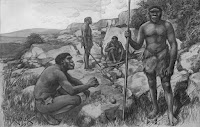For thousands of years before the advent of agriculture, hunter-gatherers were the dominant inhabitants of Central Europe. Their diet was largely meat-based, a fact that has been well documented by archaeological and paleoecological studies. Although this may seem surprising given the abundance of plant-based foods in the region, there are several reasons why meat played such a central role in the diet of these early Europeans.
Nutritional benefits of meat
Meat is an excellent source of high-quality protein, essential amino acids and other essential nutrients that are often lacking in plant-based diets. This was especially important for hunter-gatherers, who had to maintain a high level of physical activity to survive. Also, meat is higher in calories than plant foods, which means that hunter-gatherers can consume fewer calories overall to meet their energy needs.
The importance of meat in social and ceremonial life
Meat had not only nutritional value, but also played an important role in the social and ritual life of hunter-gatherers. Meat was often shared with others during feasts and communal gatherings, helping to strengthen social bonds and strengthen group identity. In addition, meat was often used in religious offerings and ceremonies, reflecting its symbolic importance.
Environmental factors affecting meat consumption
The availability of different types of prey also played a role in the diet of hunter-gatherers. In Central Europe large herbivores such as deer, wild boars and bison were abundant at certain periods and these animals were a significant source of meat. In addition, small animals such as rabbits, birds and fish were also important components of the diet.
Transition to agriculture
With the advent of agriculture about 6,000 years ago, the diet of the inhabitants of Central Europe began to change. As people began to grow crops and raise domestic animals, the proportion of meat in their diet decreased. However, even with the development of agriculture, meat continued to be an important part of the diet for many Central Europeans.
The hunter-gatherer diet in Central Europe was largely meat-based for a variety of reasons. Meat provided essential nutrients, played a role in social and ritual life, and was readily available in the environment. While the transition to agriculture led to a decline in meat consumption, meat continued to be an important part of the diet for many people in Central Europe for centuries.

Comments
Post a Comment